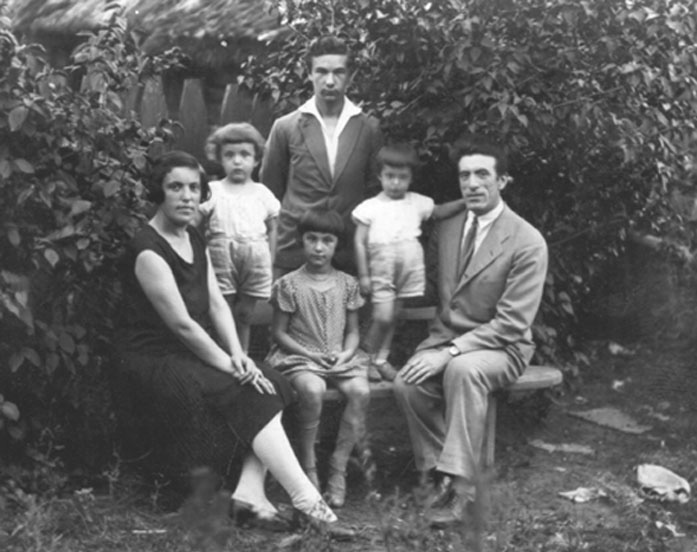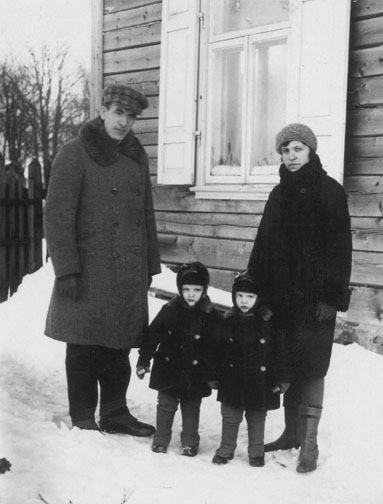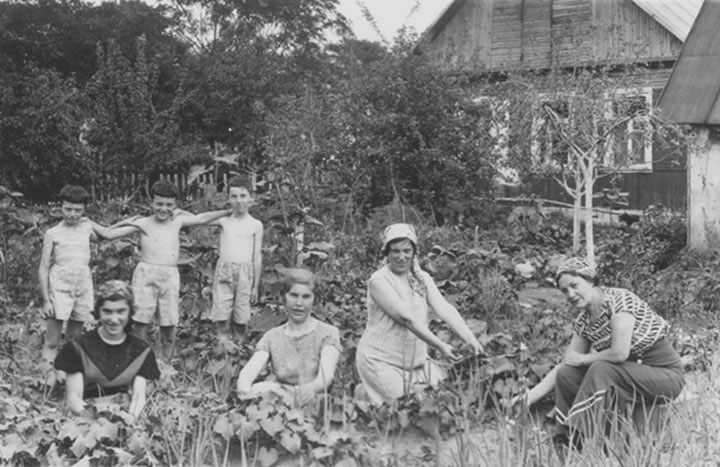

 |
| Table of Contents | ||||||
|
|
Maps |
|
Bibliography | |||
|
|
Aerial Photographs |
|
Documents | |||
|
|
Pictures |
|
Individual Families & Names | |||
|
|
History |
|
Searchable Databases | |||
Author's Note: I am indebted to my grandmother, Jenny Shelubsky Gottstein, for her account of the family of her sister, Aisne Rubinstein, residents of Rumsiskes during the 1930s. Jenny and her five sisters grew up in the village of Preny (modern Prienai) only twenty miles away, where her mother's family had lived for several generations. Jenny followed in the footsteps of the many eastern European Jews who had emigrated and had started a new life in the US, where she was joined later by two of her sisters. Most of her relatives remained behind in Lita, yet she was bound by the close ties of this large family.
The mid-1930s found Jenny living in San Francisco, California with her two grown children, where she was increasingly concerned over the rise of Nazism in Germany, and fearful for the welfare of her family in Lithuania. With the financial assistance of her sister Molly and her husband, she traveled back to Eastern Europe in 1937, hoping to convince her remaining family to leave, and come to the apparent safety of the United States. Her mission was unsuccessful, and was filled with surprises. She spent two months in Lithuania, staying with her three sisters and other family members. Her weekly letters to my mother are the basis of this portrait of the Rubinsteins, a middle class Litvak family living in Rumsiskes.
More than thirty years has passed since my grandmother left her shtetl and her homeland. Many changes were to be found. Preny was full of ghosts for her and she found it depressing. Her parents had both died more than fifteen years earlier, and her visit to their graves in the Jewish cemetery was more painful than she had expected. Her sister Sorah lived in the family home on the market square, and with her husband Alter and young son of twelve years, were sinking deeper into poverty and depression. She recognized many villagers' faces but had forgotten many of their names.
Another sister, Rose, with whom she was close, lived now in Kovna with her second husband, having raised her son Hirshel largely on her own before remarrying. Jenny spent a week with Rose there, and found many changes in Kovna. The city had become electrified, and automobiles were beginning to jam the narrow streets. She commented on the obvious, somewhat flaunted wealth of some town residents, a number of whom were Jewish.
When Jenny left the shtetl, her youngest sister Aisne was only five years old, and she knew her mostly from photos. In 1920 Aisne married Jeremiah Rubinstein, a Polish Jew who was a practicing pharmacist. Aisne was dark and pretty, with her hair in a stylish bob;
Jeremiah, known as "Jol" (photo), was tall, craggy, and possessed a chiseled good looks . They started their family in Preny, but by then, Aisne's parents were gone, with the death of her beloved father in 1923. Jol found an opportunity in nearby Rumsiskes, where he established his pharmacy, Aptiek Rumsiskes (photo).
My grandmother travelled by autobus to Rumsiskes to get reacquainted with her "little sister" and spend time with her family. By this time there were four children, and the Rubinsteins had settled into a large farmhouse on the outskirts of town. The house had an enclosed yard, a large vegetable garden, outbuildings, a small orchard, and a cow. Because the house was large and family life there was congenial, Jenny settled in and stayed a while. The children were friendly, well-behaved, and generally helpful around the house. Chana was now fourteen, was pretty and was doing well in school, speaking four languages. Aisne's twin boys, Chanania and Yosef-Pesakh were now nine and ran around in short pants. The youngest child, Shlomo, had been born in 1936 and was a toddler.
Life was pleasant for this family, with the domestic activities centering on gardening, cooking, laundry, and caring for the children. The family diet was largely vegetarian, with much food in the summer, coming from the garden (photo), in which they grew eggplant, cabbage, beets, and rootcrops of various kinds, and a little fruit from the trees. A typical meal consisted of fresh-baked bread and borchst loaded with dollops of sour cream made from the cow's milk.
A pleasurable day on the weekends consisted of the family being at home, while Aisne worked in the garden and cooked, with a Sunday symphony coming over the airwaves on the newest acquisition, the radio. Services in the village were improving and the family was enjoying the Yiddish publications that were now available though the lending library. In particular, Jol and Aisne were enjoying reading the stories of Sholom Aleichem to the children.
Jenny went into town and stopped at the pharmacy to post letters and shop. Jol teased her that she was looking pale, and recommended that he should give her an injection of `vitamins' and other supplements to counteract anemia, which were becoming fashionable with those who could afford them. As proprietor of the pharmacy, he could easily process the photographic film he was taking regularly with his camera. His dozens of pictures of the children, family gatherings, the yard and gardens, even the Nieman River ferry, formed an important part of our photo collection of our 'old-world' family that stayed behind.
About this time, Aisne's nephew Hirshel in Kovna was completing his studies in the university, having specialized in chemistry with a credential in pharmacology. He began to assist his uncle in the drugstore in Rumsiskes. During Jenny's stay, Jol wanted to attend a pharmacology conference, and Hirshel came to Rumsiskes to substitute for his uncle for a week.
One afternoon, Jol insisted that the adults take a hike, something he liked to do. He grabbed some edibles, put on sturdy footwear, and with Aisne and Jenny in tow, went bounding off across the fields and through the woods. They covered several kilometers before being hailed by some residents who recognized Jol from the pharmacy. They insisted that he and his companions come in and join them for a meal in their farm house. Being an amiable sort, Jol was inclined to accept, so they all joined this Gentile family for a repast of fresh farm produce and cooked foods. The visit was pleasant and they sat and ate, drank and told stories until suddenly the daylight began to fade. They jumped up, apologizing for having to take such sudden leave, and departed, hurrying back through the darkening countryside to get back home before the family at home would be worried.
As the visit drew near to an end, it became clear that Jenny's family had been seeing a gradual improvement in their lives. In spite of anti-Semitism, economic sanctions against Jewish business, and other difficulties, there seemed to be the perception that life was clearly getting better. Jol and Aisne had read with interest of the upcoming 1939 New York World's Fair. No, there was no interest in resettling in the United States, but Jenny's sister and her family considered coming to visit for the fair.
Our collection of letters and photos trail off after 1938. As the war began to unfold quickly in the East, contact was lost with our family in Lithuania. It is unlikely that any of these relatives survived the first years of the conflict and, although we are still searching, we have found no evidence of their survival to this day.
Compiled by Les Shipnuck, Berkeley, CA 2002



Rabbi Ben-Zion Saydman
Compiled by Vic Mayper and Benzi Saydman
Web site layout and banner by Jose Gutstein
Updated by VM: April 5, 2010
Updated by rLb: April 2020
Owner: Rabbi Ben-Zion Saydman
Copyright © April 2020
JewishGen Home Page | ShtetLinks Directory
This site is hosted at no cost by JewishGen, Inc., the Home of Jewish Genealogy.
If you have been aided in your research by this site and wish to
further our mission
of preserving our history for future generations,
your JewishGen-erosity
is
greatly appreciated.